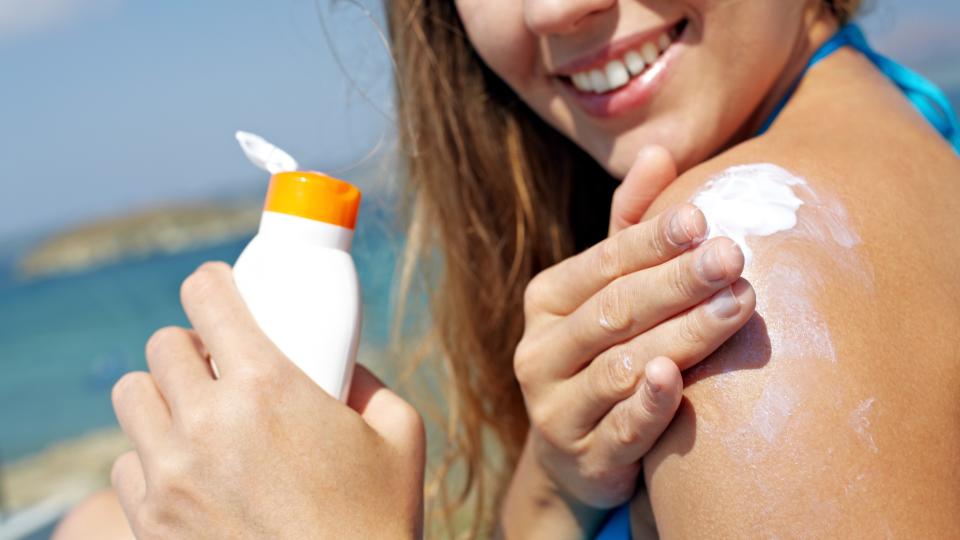Hawaii Bans Chemical Sunscreen to Save Its Coral Reefs [Updated]
UPDATE (January 4, 2020 10:45 A.M. EST): As of January 1, Hawaii's ban on chemical sunscreens is in full effect. Specifically, the ban applies to the sales and distribution of sunscreens made with ingredients oxybenzone and octinoxate, that research shows can contribute to the damage to coral reefs when washed off skin and into the water.
According to the New York Times, the ban has been opposed by some makers of chemical sunscreens, who point out that both ingredients banned are FDA-approved and can prevent skin cancer. Nevertheless, there are still plenty of reef-safe sunscreens out there that provide all the same UV protection with physical blockers like titanium dioxide and zinc oxide. The minerals in a sunscreen must be considered "non-nano" (meaning bigger than 100 nanometers) in order to be considered safe for the ocean.
Look for a sunscreen labeled "reef-safe" or "marine-safe" like Tropic Sport — and be sure to pick one that's SPF 30 or higher.
UPDATE (May 2, 2018 3 P.M. EST): It's official: Hawaii is the first state to pass a bill to ban the sale of sunscreens made with ingredients typically found chemical-based sunscreens.
Senate Bill 2571 passed on May 1, which will prohibit the sale and distribution of sunscreens made with ingredients oxybenzone and octinoxate, is currently awaiting the signature of the Hawaii governor. The bill will go into effect January 1, 2021.
UPDATE (April 30 6 P.M. EST): The fight to save the country's coral reefs continues. Last spring, we reported that oxybenzone, a chemical compound found in many non-mineral sunscreens, can cause major damage to coral reefs. To combat said damage, Hawaii senators introduced a bill to the state's Congress that would ultimately ban the sale of sunscreens made with ingredients oxybenzone or octinoxate.
The newly proposed bill, Senate Bill 2571, aims to prohibit the sale of chemical-based sunscreens made with the aforementioned ingredients. "It shall be unlawful to sell, offer for sale, or distribute for sale in the state any SPF sunscreen protection personal care product that contains oxybenzone or octinoxate, or both, without a medically licensed prescription," states the proposed bill.
On April 27, lawmakers gathered to vote on the bill, which passed with amendments. A final decision will be made Tuesday, May 1, during which lawmakers will decide whether or not Hawaii will be the first state to ban the sale of sunscreen formulated with oxybenzone or octinoxate. If passed, the ban is set to go into effect within the next couple of years.
This story was originally published on April 21, 2017.
You've heard it before, from everyone, really — your mom, certainly your dermatologist, and maybe, the most obvious of sources, from us — the importance of slathering on sunscreen before heading outdoors. Some would argue that applying SPF 30 head-to-toe is almost as crucial as sipping your daily dose of water. But even as we continue to wax poetic about the dangers of sun damage and potential for skin cancer, it turns out recent studies have found that one of the most common ingredients found in chemical sunscreens could be threatening the health of the world's coral reefs.
A 2015 study found that oxybenzone, a chemical compound associated with causing photoallergic reactions and is found in many non-mineral sunscreens, can cause major damage to coral reefs. When the ingredient washes off into the water — an inevitable occurrence as the EWG points out that an estimated 25 to 60 million (yes, million) bottles worth of sunscreen chemicals dissolve in the ocean in areas where there are coral reefs every. Single. Year. And about a quarter of the sunscreen applied to the skin is released into the water within 20 minutes of getting in it — the chemicals can make their way into the coral reefs. This can cause young coral to be trapped in their own skeletons, which hinders their growth and can ultimately lead to death.
The researchers analyzed six coastal regions in South Carolina and discovered oxybenzone in a whopping 90 percent of samples from the six sites. Another study found heavily touristed areas, including the Virgin Islands, to have a high concentration of the ingredient.
While incredibly terrifying for the future state of coral reefs, these findings aren't going unnoticed. In fact, this past January, Hawaii state senator Will Espero introduced a bill to his state's Congress, which suggested banning the sale of sunscreens containing the harmful-to-the-reefs ingredients oxybenzone and octinoxate in the state of Hawaii.
Because coral reefs are located across the globe (and not just in Hawaii), here's how you can help minimize the damage to coral reefs in the meantime: When shopping for sunscreen, read the label and check the ingredients before you buy. Does the formula contain oxybenzone? If so, consider swapping out your go-to chemical SPF for something mineral-based and made with active ingredients, zinc oxide and titanium dioxide (like the Readers' Choice Award-winning Coola Mineral Sunscreen Cucumber Matte Finish Broad Spectrum SPF 30).
Mineral-based sunscreens tend to be heavier than their chemical counterparts, so, before applying, remember to shake the formula to separate and activate it, Leslie Baumann, a dermatologist in Miami, previously told Allure. Even if it comes in a tube, give it a shimmy before applying, that way, the active ingredients will be evenly dispersed on the skin.
More sunscreen facts to know:
A New Sunscreen Study Finds That It Can Reverse Signs of Aging
Many Sunscreens Don't Meet American Academy of Dermatology Standards
Now, here's a recap on the history of sunscreen:
Follow Sarah on Twitter and Instagram.
Originally Appeared on Allure


